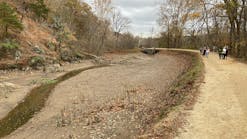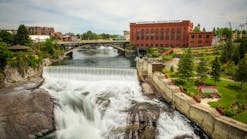The first of its kind, Maine’s Long Creek Stream restoration project has begun in an effort to stop erosion and restore the creek’s flood plain.
This is part of a 10-year effort to fix the damage done to the Long Creek watershed since the mall area emerged in the late 1960s. Heavy-equipment operators are placing stones in washed out areas, removing a misplaced earthen berm that caused further erosion and building in-stream structures that will slow the creek and encourage wildlife to return, according to Journal Tribune. They are also mixing oxygen into the creek to retain organic matter and nutrients.
Long Creek is rated a Class C stream under the Maine Water Classification Program, but it does not meet the water quality standards necessary for that classification. Pollution from uncontrolled runoff has qualified Long Creek as an urban-impaired stream. Through the decades, Long Creek has been damaged by erosion from lack of stormwater control, increased water temperature from lack of shade in certain areas and reduced dissolved oxygen.
Repeated studies have found that “years of urbanization have significantly impaired the stream’s health, as well as its ability to support recreation and wildlife, such as brook trout,” according to the Long Creek Watershed Management District’s (LCWMD) website.
“We have to work with what we’ve got here,” said John Field, a stream-restoration specialist who is directing the project. “We’re not restoring the creek back to the way it was 100 years ago.”
Although the Trump administration revoked a 2015 rule that gave the EPA authority to protect wetlands and streams from pollution, this will not stop the work that is underway. The EPA imposed a provision in the Clean Water Act in 2009 that requires property owners in the watershed with 1 or more acres of impervious ground cover to control storm water discharges and get a pollution discharge elimination permit from the Department of Environmental Protection (DEP). This led 89 property owners in the mall area to sign onto the district’s general permit, while 46 other properties got individual permits, according to the Journal Tribune. Each property owner pays a $3,000 annual fee to support the district’s watershed management efforts.
“It’s not just government agencies that got together. The landowners did, too,” said Fred Dillon, South Portland’s stormwater program coordinator to the Journal Tribune.
Read more articles on watershed here:






